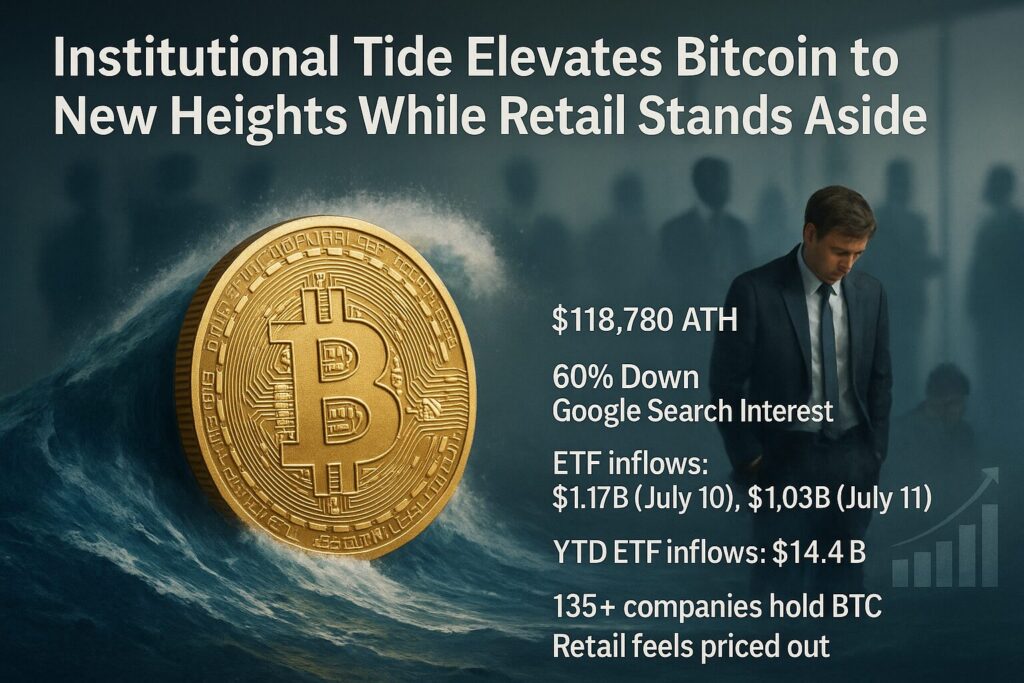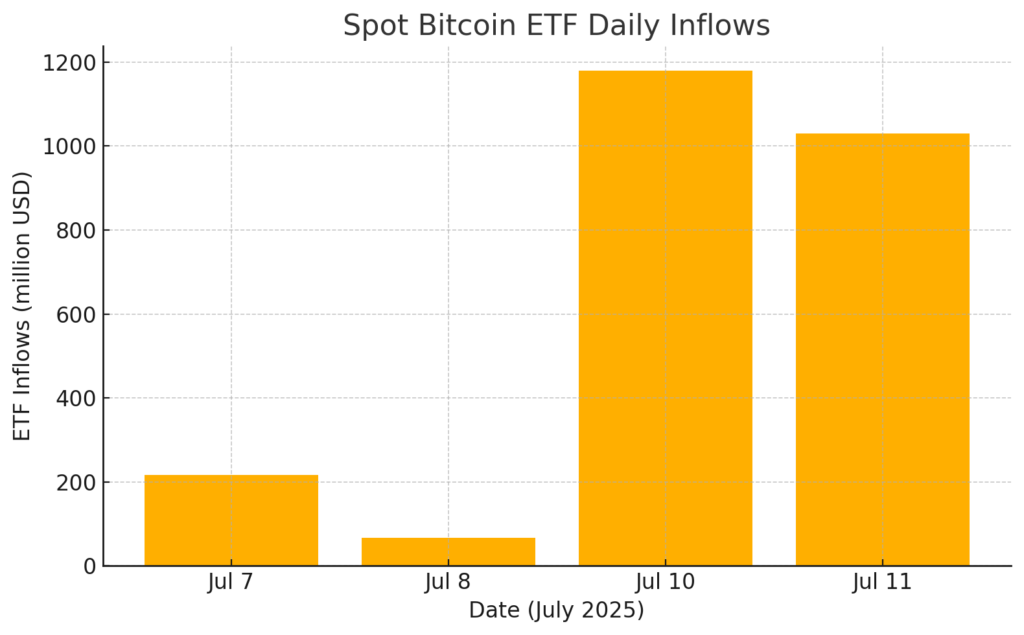
Main Points:
- Bitcoin reached an unprecedented all-time high of $118,780 in early July 2025.
- Google search interest for “Bitcoin” remains down 60% compared to the November 2024 surge.
- Spot Bitcoin ETFs logged back-to-back days with over $1 billion in inflows—$1.17 billion on July 10 and $1.03 billion on July 11.
- Year-to-date ETF inflows have exceeded $14.4 billion, demonstrating strong institutional demand.
- Major corporations and hedge funds increasingly allocate Bitcoin as a treasury asset, with over 135 public companies holding BTC reserves.
- Experts warn of Bitcoin’s volatility and note that retail investors feel “priced out” at current levels.
1. Record-Breaking Peak Driven by Institutions
In the week of July 6–12, 2025, Bitcoin (BTC) smashed through its previous ceiling, first crossing $111,970 and then scaling to $118,780 on July 11—a gain of over 6% in just two trading sessions. This landmark rally outpaces many traditional assets: the S&P 500 advanced roughly 7% year-to-date, while Bitcoin’s ascent surpasses 25%. Analysts attribute the surge to major institutional actors—asset managers, corporate treasuries, and hedge funds—seeking alternative hedges amid persistent market volatility.
Subsection Highlights:
- Corporate Adoption: Companies such as MicroStrategy and BlackRock continue to bolster their balance sheets with BTC allocations, treating it akin to digital gold.
- Legislative Support: The U.S. Senate’s passage of the GENIUS Act has further legitimized crypto assets, enabling private entities to issue regulated stablecoins.
- Macroeconomic Tailwinds: A comparatively weak U.S. dollar and concerns over inflation have driven institutional demand as investors diversify their portfolios.
2. Retail Apathy Despite Price Surge
Despite Bitcoin’s blistering performance, individual investors have remained largely on the sidelines. Bitwise’s head of research in Europe, André Dragosch, noted that Google search volume for “Bitcoin” has stagnated, showing no corresponding spike to price movement. In fact, search interest is down 60% since the week of November 10–16, 2024, when BTC first broke above $100,000 following the U.S. presidential election.
Several factors underpin this retail skepticism:
- High Entry Cost: At around $118,000 per BTC, many small investors feel they’ve missed the opportunity or cannot commit large capital.
- Volatility Concerns: Past fluctuations—such as the sub-$75,000 trough earlier this year—have fostered caution.
- Regulatory Uncertainty: While legislative progress continues, retail participants remain wary of abrupt policy shifts.
3. The ETF Catalyst: Unprecedented Inflows
A key driver of the current rally has been spot Bitcoin ETFs, which have rapidly become a primary conduit for institutional capital. Farside data shows that, on July 10, U.S.-listed spot Bitcoin ETFs attracted $1.17 billion, followed by $1.03 billion on July 11—marking the first consecutive days of billion-dollar inflows since their January 2024 debut.
Today’s bar chart illustrates ETF flows (in million USD) for select dates in early July 2025. Note the pronounced jump on July 10–11 compared to earlier in the week:
(See bar chart above)

Year-to-date, spot Bitcoin ETFs have amassed more than $14.4 billion in net inflows, making them the fastest-growing funds in history. Such inflows have reduced Bitcoin’s liquid supply on exchanges—from 18% of total supply at the start of 2025 to just 14%—further tightening available inventory and amplifying price movements.
4. Broader Corporate and Institutional Adoption
Beyond ETFs, corporate treasuries have increasingly embraced Bitcoin as a hedge against inflation and currency devaluation. Over 135 publicly traded firms now hold BTC on their books, mirroring the playbook of early adopters like MicroStrategy. Meanwhile, major financial institutions, including BlackRock and Fidelity, have launched dedicated digital asset divisions, offering custody and trading to their wealth management clients.
Key trends include:
- ETF AUM Milestones: IBIT became the fastest ETF to reach $80 billion in assets under management.
- Strategic Bitcoin Reserves: Some corporations earmark up to 5% of their cash holdings to BTC, viewing it as part of a diversified treasury strategy.
- Institutional Products: Structured Bitcoin notes, derivatives, and fixed-income products tied to BTC are proliferating in the institutional marketplace.
5. Risks, Volatility, and Future Outlook
While the institutional tide has driven Bitcoin’s latest rally, experts caution that volatility remains a defining characteristic. The U.K.’s Financial Conduct Authority has warned that investors should be prepared to lose their entire stake, citing the lack of intrinsic fundamentals and susceptibility to regulatory crackdowns.
Looking ahead, several catalysts could shape Bitcoin’s trajectory:
- Regulatory Clarity: Passage of the CLARITY Act and Anti-CBDC Surveillance State Act may further bolster mainstream adoption or, conversely, introduce new compliance burdens.
- Market Saturation: A potential catalyst for renewed retail interest could be BTC dipping below a psychological threshold, perhaps around $90,000–$100,000.
- Institutional Innovation: Launch of crypto-linked debt instruments, custody solutions, and retirement vehicle integrations could unlock fresh demand.
Conclusion
Bitcoin’s ascent to $118,780 in July 2025 underscores a seismic shift toward institutional control of the market, fueled by record ETF inflows and corporate treasury allocations. Meanwhile, retail investors remain sidelined, deterred by high entry points and lingering volatility. As regulatory frameworks evolve and new financial products emerge, the next phase of Bitcoin’s journey will hinge on balancing institutional momentum with broader retail participation. Whether this rally marks a paradigm shift toward mainstream finance or a transient institutional phenomenon, one thing is clear: Bitcoin’s role in global portfolios has never been more pronounced.

